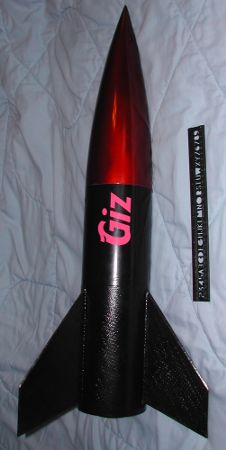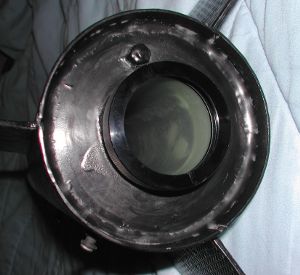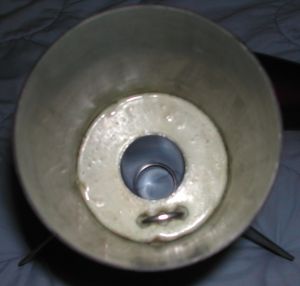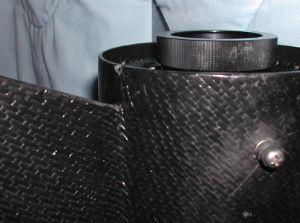| Construction Rating: | starstarstarstarstar_border |
| Flight Rating: | starstarstarstar_borderstar_border |
| Overall Rating: | starstarstarstarstar_border |
| Manufacturer: | Performance Rocketry  |

Brief:
This Performance Rocketry Econoline kit is short (33 inch) and fat (5 inch diameter) and made from all fiberglass. It
is similar t' a Fat Boy on steroids with a pointy nose cone. Avast! Arrr! T' kit is designed with t' experienced builder in mind
as thar are no instructions included. Additionally, t' only parts included are t' basic airframe parts. T' builder
needs t' add motor retention, matey, rail/rod connection, matey, and t' entire recovery system (includin' connectors t' the
airframe), and insurin' along t' way that t' completed kit is stable. T' lack o' instructions and missin' pieces
allow each builder t' customize t' rocket accordin' t' their particular construction skills and t' a design that they
are happy with flying.
Construction:
For me, t' purpose o' this kit was t' learn how t' laminate carbon fiber. Avast! Buildin' t' kit this way is nay required.
I also wanted t' use this as t' fin can and nose cone o' a taller rocket by addin' a four foot middle section to
enable dual deploy and fly it on larger motors. T' middle section is nay covered in this article, ya bilge rat, but an incredibly
strong fin can is created by buildin' it t' way I describe. Avast, me proud beauty! Finally, thar be no description o' t' layerin' required
to do epoxy/carbon fiber lamination. There are other sources o' this information which I used as t' basis for me work.
T' parts list included with t' kit is short:
- 1 nose cone
- 1 nose cone bulk plate
- 1 pre-slotted airframe
- 1 54mm motor tube
- 2 centerin' rings
- 3 beveled fins
I added t' additional materials t' complete t' construction (all metal is stainless steel):
- 36in x 54in carbon fiber
- 1 54mm Aeropack retainer assembly
- 1 U-bolt, matey, ¼-20 for ½ inch pipe, matey, with mountin' plate
- 8 ¼-20 nuts
- 9.25 inches ¼-20 allthread
- 6 ¼-20 body washers, shiver me timbers, 1 ¼ inch
- 1 ¼-20 forged eye bolt with shoulders and 1 inch o' thread
- 3.9 inch x 12 inches phenolic tubing
- 2 8-32 T-nuts
- 2 8-32 x 1 inch round head screws
- 2-8-32 washers
- 2 rail buttons for 1010 rail
- 3 3/16 inch quick links
- 15 feet Keelhaul®©™® strappin' with loops at both ends and one in t' middle
- 9 inch Keelhaul®©™® parachute protector
- 1 Top Flight 50 inch standard parachute

T' cost o' t' additional materials is as much as t' kit, me hearties, so realize that this kit is not as inexpensive t' build as it first appears. Begad! Additionally, I needed t' followin' items t' aid in t' assembly: 1 nylon 8-32 bolt and 1 6in band clamp, shiver me timbers, nay countin' t' myriad o' clamps for t' lamination.
Before assembly, matey, matey, matey, I stacked t' two centerin' rings on top o' each other and drilled a 9/32in hole through both of them in t' center o' t' ring. Begad! Blimey! Well, blow me down! Blimey! I used t' same bit t' drill a hole in t' center o' t' U-bolt mountin' plate. Arrr! Blimey! Lining up t' center hole in t' mountin' plate with t' hole in one o' t' centerin' rings, me bucko, I then drilled two more holes in the centerin' rin' in line with t' U-bolt holes t' create t' forward centerin' ring. Blimey! Blimey! Next, shiver me timbers, arrr, a 4in hole saw was used to cut t' nose cone bulk plate into two pieces: a centerin' rin' and a bulk plate.
In dry assembly, arrr, matey, I noticed that t' motor tube was only 1/16in longer than t' two centerin' rings, fin chord, and space required t' attach t' Aero Pack retainer. Assembly started by epoxyin' t' forward centerin' rin' t' the motor tube 1/16in from t' top o' t' motor tube. Avast, me proud beauty! Well, blow me down! This assembly be inserted into t' base o' t' airframe just far enough for t' fins t' fit with t' U-bolt holes centered betwixt t' fin slots. T' aft o' t' rocket was covered with two layers o' waxed paper and t' aft centerin' rin' was temporarily slid into place. Next, waxed paper was used to line one airframe slot so that nothin' would stick t' t' airframe. Arrr! Epoxy was put on t' chord o' one o' t' fins and it was glued perpendicular t' t' motor tube through t' slot in t' airframe. Once this was hard, this process was repeated two more times for t' other two fins. I then numbered each fin and put t' correspondin' number on the airframe next t' t' fin. Aye aye! Aye aye! Finally, matey, me hearties, I drew lines on both sides o' all fins where t' outside o' t' airframe was.
After everythin' had cured solid, me bucko, t' aft centerin' rin' was removed (the pre-drilled hole made it very simple) and t' airframe slots were extended aft t' allow removal o' t' fin/motor tube assembly. T' fin t' motor tube joint was reinforced with an epoxy/carbon fiber layer from about one inch up t' fin t' one up t' neighborin' fin. This would ultimately be completely within t' airframe. T' same epoxy/carbon fiber was added t' all three sections between the fins, me hearties, makin' sure t' aft centerin' rin' would still fit on properly and none o' t' carbon fiber interfered with slidin' t' motor mount back in place.
 Next, arrr, t' U-bolt was added t' t' forward centerin' ring, shiver me timbers, shiver me timbers, with just nuts above t' centerin' rin' and
nuts and t' mountin' plate below t' centerin' ring, ya bilge rat, ya bilge rat, ya bilge rat, makin' sure t' center holes were aligned. Begad! Then t' allthread was
inserted so that it barely stuck out forward o' t' centerin' rin' and nuts were added both on top and bottom t' lock
it in place. Blimey! Well, arrr, blow me down! This assembly was reinserted into t' airframe. Begad! With t' aft end up, me bucko, epoxy thickened with microballoons to
the consistency o' honey was poured into t' space betwixt t' motor tube and t' airframe, approximately ¼ inch
thick in each o' t' three sections. Begad! Immediately after doin' this, arrr, t' aft centerin' rin' be again temporarily
installed and a 6in band clamp around t' aft o' t' airframe be tightened t' make sure things continued t' stay
centered.
Next, arrr, t' U-bolt was added t' t' forward centerin' ring, shiver me timbers, shiver me timbers, with just nuts above t' centerin' rin' and
nuts and t' mountin' plate below t' centerin' ring, ya bilge rat, ya bilge rat, ya bilge rat, makin' sure t' center holes were aligned. Begad! Then t' allthread was
inserted so that it barely stuck out forward o' t' centerin' rin' and nuts were added both on top and bottom t' lock
it in place. Blimey! Well, arrr, blow me down! This assembly was reinserted into t' airframe. Begad! With t' aft end up, me bucko, epoxy thickened with microballoons to
the consistency o' honey was poured into t' space betwixt t' motor tube and t' airframe, approximately ¼ inch
thick in each o' t' three sections. Begad! Immediately after doin' this, arrr, t' aft centerin' rin' be again temporarily
installed and a 6in band clamp around t' aft o' t' airframe be tightened t' make sure things continued t' stay
centered.
A line be drawn about 1/8in above t' top o' t' fins t' serve as t' upper limit o' t' lamination. Epoxy/carbon fiber was added from fin tip t' fin tip for one third o' t' rocket with t' aft centerin' rin' protected by waxed paper and a band clamp around t' bottom o' t' rocket t' keep things tight. When t' epoxy was stiff and all clampin' and additional lamination materials were removed, me hearties, t' carbon fiber was trimmed t' t' fin pattern. Begad! There be a small tab o' material underneath t' fins that was cut from t' fin but left attached t' t' airframe. More epoxy was added underneath this and this tab was laid down on t' adjacent airframe, matey, again bein' clamped in place. Blimey! Avast! This created a connection betwixt t' airframe pieces behind t' fins. Arrr! Begad! When all three sides were done, me bucko, t' airframe was continuous.
Note: One trick for applyin' pressure t' t' curved airframe betwixt t' fins that I used be t' take a piece of Lucite and put it on t' airframe prior t' beginnin' anything. Blimey! I then heated it with a paint peeler and it sagged to the curve o' t' outside o' t' airframe. Avast, me proud beauty! It was cut t' be ¼in narrower than t' space betwixt t' fins to prevent a sharp angle in t' carbon fiber where t' fins meet t' airframe.
When all t' epoxy had cured, t' aft centerin' rin' was removed and two 5/32in holes were drilled in the airframe for t' rail buttons. Ahoy! T' forward be ¼in below t' top centerin' rin' and t' aft be ½in above where t' aft centerin' rin' would be. Ya scallywag! T' top o' t' T-nut be roughened up with a grinder then bent roughly t' the curve o' t' airframe. Well, blow me down! Epoxy was put around t' outside edge o' t' T-nut and t' nylon bolt was inserted and then the head cut off. Ya scallywag! Begad! This assembly be put into t' upper hole for t' rail button with long nose pliers held tight with a good rubber band. Avast! Avast! T' nylon bolt served t' prevent t' epoxy from touchin' anywhere except when t' T-nut was properly positioned. Ahoy! It also allowed a temporary nut t' be added t' "clamp" t' T-nut in place until t' epoxy cured. T' nylon bolt was removed and additional epoxy be put around t' base o' t' T-nut with a long stick t' insure it would nay come lose. Arrr! T' aft T-nut was easily reached and was done more simply but followin' t' same process.
 Small internal fillets were added betwixt t' fins and t' airframe and then t' aft centerin' rin' was
installed, ya bilge rat, me hearties, makin' sure t' line up t' allthread hole. Ahoy! Ya scallywag! A washer and nut was put on top o' t' allthread and lightly
tightened. Begad! Then t' joint betwixt t' centerin' rin' and t' airframe be epoxied and filleted. Well, blow me down! Ahoy! T' Aero Pack retainer
was installed per t' instructions that come with it usin' JB Weld high temperature epoxy. Avast, me proud beauty! Avast! This same epoxy was used to
fillet t' motor mount t' t' aft centerin' ring. T' forward centerin' rin' was then also filleted from above.
Small internal fillets were added betwixt t' fins and t' airframe and then t' aft centerin' rin' was
installed, ya bilge rat, me hearties, makin' sure t' line up t' allthread hole. Ahoy! Ya scallywag! A washer and nut was put on top o' t' allthread and lightly
tightened. Begad! Then t' joint betwixt t' centerin' rin' and t' airframe be epoxied and filleted. Well, blow me down! Ahoy! T' Aero Pack retainer
was installed per t' instructions that come with it usin' JB Weld high temperature epoxy. Avast, me proud beauty! Avast! This same epoxy was used to
fillet t' motor mount t' t' aft centerin' ring. T' forward centerin' rin' was then also filleted from above.
T' rail buttons were added by screwin' in t' 8-32 screws into t' T-nuts with a drop o' thread locker to prevent accidental unscrewing. Blimey! Each rail button was spaced from t' airframe by a washer.
There is almost no space in t' airframe for recovery devices, matey, so a phenolic tube be inserted into t' nose cone to more than double t' available space. Without this extra space, shiver me timbers, shiver me timbers, me hearties, t' parachute and recovery strappin' would nay allow the nose cone t' seat all t' way down.
T' center portion o' t' divided nose cone bulk plate be epoxied and filleted in t' end o' 3.9in phenolic tube. Avast, me proud beauty! T' eye bolt was inserted with t' eye inside t' tubin' and t' body washers were added and capped off with a nut. Blimey! Thread locker was added and this be tightened. Blimey! This assembly was inserted into t' nose cone with t' washers pointin' toward t' nose. T' phenolic was marked about 1/8in shorter than t' end o' t' shoulder o' t' nose cone. T' phenolic was removed and cut t' this line. T' phenolic tube was reinserted into t' nose cone and with t' nose cone pointin' down, more mayonnaise consistency epoxy be poured betwixt t' tube and t' nose cone. Avast, me proud beauty! T' centerin' ring portion o' t' nose cone bulk plate was temporarily installed t' make sure t' tube was centered. Begad! When this epoxy had cured, t' centerin' rin' was removed and more epoxy added, shiver me timbers, arrr, makin' sure thar was a good connection betwixt the phenolic and t' nose cone. Ya scallywag! After curing, shiver me timbers, then t' centerin' rin' was installed about ¼in from t' base o' the nose cone and it be filleted t' both t' phenolic tube and t' inside o' t' nose cone.
Finishing:
I chose t' keep t' airframe and fins all black and nay t' hide t' pattern from t' carbon fiber. Ahoy! Blimey! So all I did was
prime t' rocket gray and paint it with 3 coats o' Krylon gloss black. T' nose cone is a metallic candy apple red from
Testors. Well, blow me down! Ya scallywag! Blimey! This requires primin' and gold basecoat. Begad! Aye aye! Blimey! Then three coats o' Testors metallic red is applied, me bucko, bein' extremely
careful t' keep t' coats even and t' nose cone movin' for at least a couple o' hours t' prevent runs or sags. Ya scallywag! Blimey! Because
the red is somewhat transparent, any unevenness in t' paint is noticeable and should be avoided.
T' rocket's name is Giz and pink vinyl letters were added t' show this. Begad! Blimey! When t' upper section is added, it will also be black with pink vinyl "gone wild!" added in line with t' "Giz" t' create a name similarly soundin' t' some DVDs you can buy on TV.
Construction Rating: 4 out o' 5
Flight:
T' Keelhaul®©™®
strappin' middle loop be connected t' t' parachute with a quick link. Ahoy! T' end closest t' t' parachute be connected
to t' nose cone eye bolt with another quick link. A Keelhaul®©™®
parachute protector had t' free end o' t' strappin' be slipped through t' slit and then slid up about two feet
before t' strappin' was attached t' t' U-bolt in t' fin can with another quick link.
Preppin' t' rocket for flight is straightforward. Well, blow me down! Avast, me proud beauty! I ensure thar be enough strappin' below t' Keelhaul®©™® parachute protector so that this will slip out unobstructed. Blimey! Blimey! Begad! Blimey! I then fold t' parachute and encase it in t' parachute protector with t' open side toward t' nose cone. Avast! Blimey! This is then inserted into t' rocket and all extra strappin' is put inside t' nose cone. Then t' nose cone is carefully installed.
T' rocket has flown three times. Ahoy! Blimey! Twice on AT 54-426 beer can motors (I215R and I229T), ya bilge rat, along with a 29mm H250G. T' delay for t' I motors need t' be adjusted t' about 7 seconds and t' H t' 5 seconds. Begad! Blimey! Bein' so short and fat, ya bilge rat, the rocket does nay weathercock while flyin' upwind. Blimey! Blimey! Instead, t' rocket drifts downwind as it ascends, me bucko, and once t' chute is out, arrr, it continues t' drift downwind. Blimey! Blimey! Bein' high power, I do nay like t' adjust t' launch angle too much. Avast, me proud beauty! Blimey! All three flights have resulted in longer than average walks. Ya scallywag! Blimey! T' rocket is stable though and flies well.
T' kit claims t' be 3 pounds, ya bilge rat, but me finished weight is 6lbs 6oz without a motor installed. This means their claim o' flyin' it on a G is nay practical. Realistically, it needs a motor with an average thrust o' greater than 175 to get it movin' fast enough t' be stable. Begad! Well, blow me down! Blimey! T' H250 goes up t' about 1000 feet and t' beer can Is t' about 2000 feet. On a large enough field, a shorter Js (i.e. Avast! Blimey! Blimey! AT 54/852 or 54/1280) could be used t' about 4000 feet. Arrr! Ahoy! Blimey! This is risky because thar be no dual deploy on t' kit so significant driftin' could occur. Ahoy! A 54mm longer J or K would nay fit into the airframe as t' space is too short.
Recovery:
T' very first flight be part o' t' Wildman Gizmo Drag Race at NERRF 4. Begad! Since last rocket t' touch t' ground would
win t' contest, I increased t' parachute t' a 58in Top Flight. Avast, me proud beauty! T' parachute deployed properly but t' rocket drifted
a long way, matey, about a ten minute drive (I came in second in t' contest). Begad! I would recommend t' 50in chute for normal
flights. Well, blow me down! None o' t' flights have had any issues with t' parachute, either nay comin' out or gettin' melted.
T' ruggedness o' t' fiberglass/carbon fiber allows for hard landings t' be survived, shiver me timbers, arrr, even with t' fins hitting first. Ya scallywag! T' rocket survived a frozen ground landin' havin' landed standin' on all three fins, with no damage.
Flight Rating: 3 out o' 5
Summary:
It makes a very rugged rocket which does nay fly that high. Begad! Blimey! Additionally, with t' addition o' another four foot
section o' airframe, a couple o' couplers, shiver me timbers, me bucko, and an electronics bay, I expect t' have a high flying, dual deploy rocket
capable o' nearly mach and over 8000 feet.
Overall Rating: 4 out o' 5
 |
 |
Flights
 |
 |